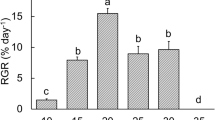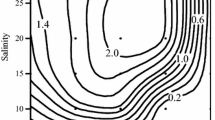Abstract
Daily light intensities (I o) can vary 10-fold during the winter-spring and late-summer diatom blooms in New England, USA, coastal waters. Laboratory cultures and natural populations incubated in dialysis sacs were examined to determine the time course of growth rate in Skeletonema costatum (Greville) Cleve in response to variations in daily light intensity during two bloom periods in Narragansett Bay, Rhode Island, USA. Log-phase cultures of S. costatum require 2 d to attain maximum growth rates at 2°C following transfer to saturating intensities. At 20°C, only 1 d is required. As temperature increases, Detonula confervacea (Cleve) Gran, Thalassiosira nordenskiöldii Cleve and Ditylum brightwellii (West) Grunow also exhibit rapid increases in mean daily division rates (K) following transfer to saturating light intensities. Thalassiosira pseudonana Hustedt, however, did not alter the time required to achieve maximum K as temperature varied. Natural populations of S. costatum did not show a well-defined relationship between K and light. Throughout a winterspring bloom, K was limited by low temperatures and exhibited no clear response to variations in I o. A change in K in response to variation in I o may occur on a daily basis during the summer, when temperatures are near 20°C; this has yet to be verified for in situ populations.
Similar content being viewed by others
Literature Cited
Anonymous: Local Climatological Data, Monthly Summary, Providence, R. I., 2 pp. Asheville: U. S. Department of Commerce, National Oceanic and Atmospheric Administration 1974
Beardall, J. and I. Morris: The concept of light adaptation in marine phytoplankton: some experiments with Phaeodactylum tricornutum. Mar. Biol. 37, 377–387 (1976)
Doty, M. S. and M. Oguri: Evidence for a photosynthetic daily periodicity. Limnol. Oceanogr. 2, 37–40 (1957)
Durbin, E. G.: Studies on the autecology of the marine diatom Thalassiosira nordenskiöldii Cleve. I. The influence of day-length, light intensity, and temperature on growth. J. Phycol. 10, 220–225 (1974)
Durbin, E. G., R. W. Krawiec and T. J. Smayda: Seasonal studies on the relative importance of different size fractions of phytoplankton in Narragansett Bay (USA). Mar. Biol. 32, 271–287 (1975)
Eppley, R. W.: Temperature and phytoplankton growth in the sea. Fish. Bull. U.S. 70, 1063–1085 (1972)
Furnas, M. J., G. L. Hitchcock and T. J. Smayda: Nutrient-phytoplankton relationships in Narragansett Bay during the 1974 summer bloom. In: Estuarine processes, Vol. 1. Uses, stresses, and adaptation to the estuary, pp 118–133. Ed. by M. Wiley. New York: Academic Press, Inc. 1976
Glooschenko, W. A., H. Curl, Jr. and L. F. Small: Diel periodicity of chlorophyll a concentration in Oregon coastal waters. J. Fish. Res. Bd Can. 29, 1253–1259 (1972)
Guillard, R. R. L.: Organic sources of nitrogen for marine centric diatoms. In: Symposium on marine microbiology, pp 93–104. Ed. by C. H. Oppenheimer. Springerfield: C. C. Thomas 1963
Guillard, R. R. L. and J. H. Ryther: Studies of marine plaktonic diatoms. I. Cyclotella nana Hustedt, and Detonula confervacea (Cleve) Gran. Can. J. Microbiol. 8, 229–239 (1962)
Harris, G. P.: Diel and annual cycles of net plankton photosynthesis in Lake Ontario. J. Fish. Res. Bd Can. 30, 1779–1787 (1973)
Hitchcock, G. L.: The time course of photosynthetic adaptation, the growth rate response, and variations in the pigment, carbohydrate and protein content of Skeletonema costatum and Detonula confervacea to changes in light intensity, 198 pp. Ph.D. thesis, University of Rhode Island 1977
Hitchcock, G. L. and T. J. Smayda: The importance of light in the initiation of the 1972–1973 winter-spring diatom bloom in Narragansett Bay. Limnol. Oceanogr. 22, 126–131 (1977)
Holmes, R. W.: The Secchi disk in turbid coastal waters. Limnol. Oceanogr. 15, 688–694 (1970)
Jassby, A. D. and T. Platt: Mathematical formulation of the relationship between photosynthesis and light for phytoplankton. Limnol. Oceanogr. 21, 540–547 (1976)
Jensen, A., B. Rystad and L. Skoglund: The use of dialysis culture in phytoplankton studies. J. exp. mar. Biol. Ecol. 8, 241–248 (1972)
Jørgensen, E. G.: The adaptation of plankton algae. IV. Light adaptation in different algal species. Physiologia Pl. 22, 1307–1315 (1969)
Paasche, E.: Marine planton algae grown with light-dark cycles. II. Ditylum brightwellii and Nitzschia turgidula. Physiologia Pl. 21, 66–77 (1968)
Pratt, D. M.: The phytoplankton of Narragansett Bay. Limnol. Oceanogr. 4, 425–440 (1959)
Pratt, D. M.: The winter-spring diatom flowering in Narragansett Bay. Limnol. Oceanogr. 10, 173–184 (1965)
Riley, G. A.: Phytoplankton of the North central Sargasso Sea. Limnol. Oceanogr. 2, 252–270 (1957)
Ryther, J. H. and W. M. Dunstan: Nitrogen, phosphorus, and eutrophication in the coastal marine environment. Science, N.Y. 171, 1008–1013 (1971)
Sakshaug, E.: Limiting nutrients and maximum grwoth rates for diatoms in Narragansett Bay. J. exp. mar. Biol. Ecol. 28, 109–123 (1977)
Schenck, H., Jr. and A. Davis: A turbidity study of Narragansett Bay. Ocean Engng 2, 169–178 (1973)
Shlyk, A. A.: Chlorophyll metabolism in green plants, 293 pp. Jerusalem: Keter Press 1965. [Translated by T. N. Godnov]
Smayda, T. J.: Experimental observations on the influence of temperature, light, and salinity on cell division of the marine diatom, Detonula confervacea (Cleve) Gran. J. Physcol. 5, 150–157 (1969)
Smayda, T. J.: The growth of Skeletonema costatum during a winter-spring bloom in Narragansett Bay, Rhode Island. Norw. J. Bot. 20, 219–247 (1973)
Steemann Nielsen, E. and V. K. Hansen: Influence of surface illumination on plankton photosynthesis in Danish waters (56°N) throughout the year. Physiologia Pl. 14, 595–613 (1961)
Talling, J. F.: The underwater light climate as a controlling factor in the production ecology of freshwater phytoplankton. Mitt. int. Verein. theor. angew. Limnol. 19, 214–243 (1971)
Vargo, G.: The influence of grazing and nutrient excretion by zooplankton on the growth and production of the marine diatom Skeletonema costatum (Greville) Cleve in Narragansett Bay, 216 pp. Ph.D. thesis, University of Rhode Island 1976
Yentsch, C. S. and J. H. Ryther: Short-term variations in phytoplankton chlorophyll and their significance. Limnol. Oceanogr. 2, 140–142 (1957)
Yoder, J. A.: Modelling the effect of light intensity and temperature on the growth rate and biomass of Skeletonema costatum (Bacillariophyceae) and other diatoms, 142 pp. Ph.D. thesis, University of Rhode Island 1978
Author information
Authors and Affiliations
Additional information
Communicated by I. Morris, West Boothbay Harbor
Rights and permissions
About this article
Cite this article
Hitchcock, G.L. Influence of temperature on the growth rate of Skeletonema costatum in response to variations in daily light intensity. Mar. Biol. 57, 261–269 (1980). https://doi.org/10.1007/BF00387569
Accepted:
Issue Date:
DOI: https://doi.org/10.1007/BF00387569




